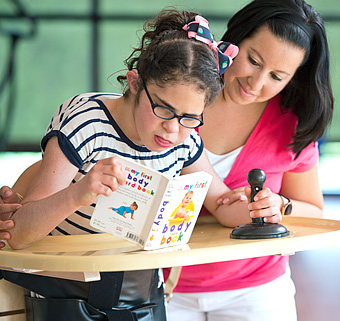Guidelines for Functional Use of Large Supine Stander
| January 2010 The Rifton Large Supine Stander has a unique new transfer height adjustment feature. When horizontal, the Large Supine Stander lowers to 21" for easy sitting transfers. While horizontal, it can be raised up to 30" to accommodate other transfers such as from a bed or gurney. Transfers can be performed effectively and safely decreasing risk of back strain for the caregiver. The crank that controls horizontal height adjustment is also used to bring the board into a vertical position.
The Rifton Large Supine Stander has a unique new transfer height adjustment feature. When horizontal, the Large Supine Stander lowers to 21" for easy sitting transfers. While horizontal, it can be raised up to 30" to accommodate other transfers such as from a bed or gurney. Transfers can be performed effectively and safely decreasing risk of back strain for the caregiver. The crank that controls horizontal height adjustment is also used to bring the board into a vertical position.
The lateral support blocks and armrests of the Large Supine Stander can be moved out of the way to give adequate room for transfers. Once the transfer is complete, the person lies flat while being stabilized as needed. The Large Supine Stander supports the posterior surface of the body and the lateral support blocks help maintain symmetry. Anterior straps are for additional security. Customized positioning of the person’s head, trunk, pelvis, knees, and feet is accomplished by using the adjustments available.
When well-stabilized, a person can be brought to the desired upright position. This manual adjustment is performed with a crank that moves effortlessly and reliably. The Large Supine Stander allows varying angles in an upright position for passive standing. The person can be elevated vertically as much as tolerated; this should be done as slowly as necessary. When the board is nearly vertical, it actually is easier to crank, due to the gas-assist mechanics of the base frame. Calibration markings on the frame base are useful to specify positioning, from 0º horizontal to 85º near vertical.
There is an adjustable tray to support the client’s arms in front, and provide a work or play surface. This tray will also accommodate an Arm Anchor when additional stability is needed. Casters are lockable for fixed or mobile positioning.
For a non-ambulatory person who is medically stable and can tolerate being partially upright, a daily standing program can be advantageous. There are notable benefits to being supported in an upright position.
Persons with flexion contractures who are non-weight-bearing can be placed in the Large Supine Stander with the pressure taken primarily through their extensor surfaces. A small amount of partial weight-bearing may be initiated in the more vertical position. Over time, tight muscles may lengthen. In the Large Supine Stander, the person is easily visible for optimal alignment.
Additional physiological benefits: Being in an upright position allows gravity to positively affect almost all systems of the body. The respiratory system may be reinforced and clear out, so that less suctioning is required. The digestive and excretory systems may be assisted, resulting in decreased constipation and improved renal function. The circulatory system can be fortified over time, resulting in prolonged tolerance for the upright position and reduced risk of fainting episodes.
There are also mental and social benefits, in viewing the classroom and environment from an upright position, participating in activities using the tray, and interacting with staff and peers. The wheels enable the Large Supine Stander to be moved around the room as desired.
The Large Supine Stander is suitable for users who lack anti-gravity control of the head and shoulder girdle. People with medical concerns involving respiratory issues such as a tracheotomy or respirator, or a gastro-intestinal tube for feeding, as well as others with hydrocephalus or spinal cord injury, may benefit from using the Large Supine Stander. For someone who has sufficient head and upper trunk control, the headboard folds down, encouraging independence.
Note:
Progressive-thinking therapists will consider the use of a Large Supine Stander as an opportunity for a client to gain tolerance in a more upright position, and a valuable way to assess safety in standing. Once these goals are accomplished, a person can be transitioned to another upright positioning device that will allow them to explore the environment, engage in functional activities and facilitate eye-level interaction with ambulatory peers.
Clients who are developmentally more capable with partial weight-bearing ability and trunk control, often utilize mobile or prone standers and can demonstrate appreciable gains from the active weight-bearing and extensor strengthening that is promoted by using these products.




